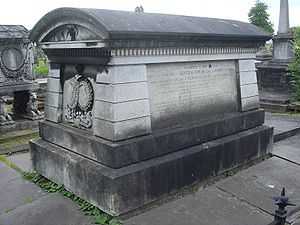De Lacy Evans
| George de Lacy Evans | |
|---|---|
 De Lacy Evans by Peter Edward Stroehling, ca. 1825 | |
| Born | Moig, County Limerick Ireland |
| Allegiance | United Kingdom |
| Service/branch | British Army |
| Rank | general |
| Commands held |
|
| Battles/wars | |
| Other work | Member of Parliament |
Sir George de Lacy Evans GCB (1787 – 9 January 1870) was a British Army general who served in four wars in which the United Kingdom's troops took part in the 19th century. He was later a long-serving Member of Parliament.[1]
Evans was born in 1787, in Moig, County Limerick, Ireland. Educated at Woolwich Academy he entered the British Army in 1806 as a volunteer, obtaining an ensigncy in the 22nd Regiment of Foot in 1807. His early service was in India, but he exchanged into the 3rd Light Dragoons in order to take part in the Peninsular war. He was sent on the expedition to the United States of 1814 during the War of 1812 under Major General Robert Ross. Evans was quartermaster general to Ross at the Battle of Bladensburg on 24 August 1814, and during the Burning of Washington, as well as at the Battle of North Point on 12 September 1814, where Ross was killed.

Returning to the European war with the restoration of Emperor Napoleon I, Evans was present at the battle of Quatre Bras on 16 June 1815 and the battle of Waterloo on 18 June 1815.
Evans commanded the British Legion which volunteered to assist Isabella II of Spain in the First Carlist War. During the Crimean War he commanded the 2nd Division of the British Army.
He served as a Member of Parliament (MP) for Rye in 1830, and from 1831 to 1832, and for Westminster from 1833 to 1841 and from 1846 to 1865. He was also awarded the Grand Cross of the French Legion of Honor.[2] Evans died on 9 January 1870, and is buried in Kensal Green Cemetery, London.
Portraits of Evans were painted by Peter Edward Stroehling (above) and Richard Buckner.[3] An engraving based on the latter is in the National Portrait Gallery, London.[3]

References
- ↑
 Chisholm, Hugh, ed. (1911). "Evans, Sir George de Lacy". Encyclopædia Britannica (11th ed.). Cambridge University Press.
Chisholm, Hugh, ed. (1911). "Evans, Sir George de Lacy". Encyclopædia Britannica (11th ed.). Cambridge University Press. - ↑ A dictionary of general biography: with a classified and chronological index of the principal names, William Leist Readwin Cates, page 44
- ↑ 3.0 3.1 "Portrait - NPG D36591; Sir George de Lacy Evans". National Portrait Gallery. Retrieved 4 June 2013.
- Adkin, Mark (2001). The Waterloo Companion. Aurum. ISBN 1-85410-764-X
- Barbero, Alessandro (2005). The Battle: A New History of Waterloo. Atlantic Books. ISBN 1-84354-310-9
- George, Christopher T., Terror on the Chesapeake: The War of 1812 on the Bay, Shippensburg, Pa., White Mane, 2001, ISBN 1-57249-276-7
- Spiers, Edward M (1983). Radical General : Sir George de Lacy Evans, 1787-1870, Manchester, U.K., Manchester University Press, ISBN 0-7190-0929-4
- Leigh Rayment's Historical List of MPs
- This article incorporates text from a publication now in the public domain: Wood, James, ed. (1907). "article name needed". The Nuttall Encyclopædia. London and New York: Frederick Warne.
- de Lacy Evans' grave at historyhome.co.uk
Further reading
- Brett, Edward M. The British Auxiliary Legion in the First Carlist War 1835-1838: A Forgotten Army. Dublin: Four Courts Press, 2005.
- Bullen, Roger and Strong, Felicity (Eds.). Prime Minister Papers Series I. Palmerston: Private Correspondence with Sir George Villiers (afterwards 4th Earl of Clarendon) as Minister to Spain 1833-1837. London: Royal Commission of Historial Manuscripts, HMSO, 1985.
- Coverdale, John F. The Basque Phase of Spain’s First Carlist War. Princeton: Princeton University Press, 1984.
- De Porras y Rodríguez de León, Gonzalo. La Expedición de Rodil y las Legiones Extranjeras en la Primera Guerra Carlista. Madrid: Ministerio de Defensa, 2004.
- Duncan, Francis. The English in Spain: The Story of the War of Succession between 1834 and 1840. London: John Murray, 1877.
- Evans, Sir George De Lacy. Memoranda of the Contest in Spain. London: James Ridgway, 1840.
- Holt, Edgar. The Carlist Wars in Spain. Chester Springs (Pennsylvania): Dufour Editions, 1967.
- Pirala, Antonio. Historia de la Guerra Civil. Madrid: Turner SA / Historia 16, 1984. (6 Volumes).
- Rodriguez, Moises Enrique. Under the Flags of Freedom: British Mercenaries in the War of the Two Brothers, the First Carlist War and the Greek War of Independence (1821-1840). Lanham (Maryland): Hamilton Books, 2009.
- Shaw, Charles. Personal Memoirs & Correspondence of Col. Charles Shaw, comprising a Narrative of the War for Constitutional Liberty in Portugal and Spain. London: Henry Colburn Publishers, 1837. (2 Volumes).
- Shelley, Ronald G. The British Legion in Spain during the First Carlist War. Brighton: Spanish Philatelic Society, 1975.
- Somerville, Alexander. History of the British Legion and the War in Spain 1835-1837. London: James Pattie, 1839.
- Spiers, Edward M. Radical General: Sir George de Lacy Evans 1787-1870. Manchester: Manchester University Press, 1983.
External links
- Hansard 1803–2005: contributions in Parliament by (George) De Lacy Evans
| Parliament of the United Kingdom | ||
|---|---|---|
| Preceded by Philip Pusey Richard Arkwright |
Member of Parliament for Rye May 1830 – August 1830 With: Richard Arkwright |
Succeeded by Hugh Duncan Baillie Francis Robert Bonham |
| Preceded by Hugh Duncan Baillie Francis Robert Bonham |
Member of Parliament for Rye 1831 – 1832 With: Thomas Pemberton |
Succeeded by Edward Barrett Curteis |
| Preceded by Sir Francis Burdett and Sir John Hobhouse |
Member of Parliament for Westminster 1833–1841 With: Francis Burdett, to 1837 John Temple Leader, from 1837 |
Succeeded by John Temple Leader and Henry John Rous |
|